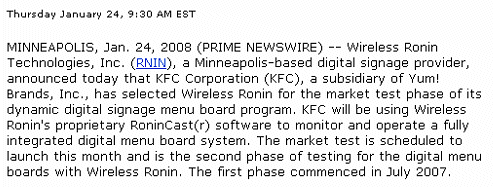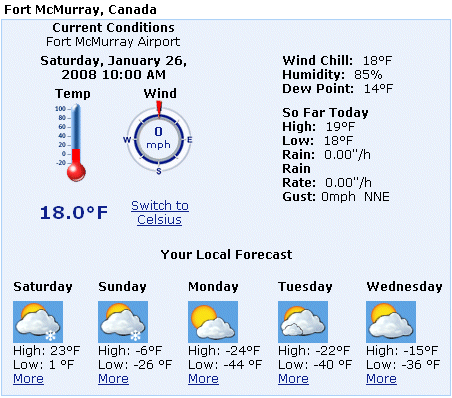



"Risk comes
from not knowing what you're doing"
~ Warren Buffet
E-Alert Update:| S&P
500 Index: 1331.29 Marketimer views the establishment of a correction bottom as a process which unfolds over a given period of time. This process involves the initial establishment of a closing S&P 500 Index low, followed by a short rally, followed by a test of the area of the previously established low on reduced trading volume. The initial closing low in the current stock market correction process occurred on January 22, when the S&P 500 Index closed at 1310.50. The market subsequently rallied for eight days, at which point it began the process of testing the area of the January 22 closing low. In our view, the correction bottoming process has proceeded with a high degree of historical consistency to date. We have witnessed a decided reduction in selling pressure during the testing process, which is essential to a successful outcome. We now rate the stock market attractive for purchase on any weakness that occurs in the current area of the S&P 500 Index low 1300's, or any minor weakness that occurs below that level. We view any such stock market weakness as an attractive buying opportunity for subscribers seeking to add to stock market positions. We regard any additional testing and probing in this S&P 500 Index price range as an opportunity to purchase equities at what we regard as bargain level prices. |
| The Professional Opinion Bob starts out the newsletter defining recession in its classical definition of an S&P 500 index decline of more than 20% on a closing basis. He points out that every bull market has had at least on decline of 10% or more and that has occurred. Corrections in the 15 - 19% range are uncommon, but not unheard of. Presidential election years are somewhat different because incumbents generally prefer to remain in office and what happens when the economy is not going in the right direction? Fiscal stimulus packages. This is one of the reasons recessions during a presidential election are generally brief and mild. In 1960 and in 1980 there were brief and mild recessions of 16 - 17% and in each election year the market bottomed out in February through April. In Bob's view the door is open to a brief and mild recession with economic weakness in the first two quarters possibly going negative, but not by much. Jobless claims rose sharply in January and retail sales have slowed. The checks in the mail from Uncle Sam should help offset the impact of high energy prices. The anticipated slowdown in economic growth in the first half, with a recovery underway in the second half of the year as resulted in a lowered estimate of real GDP growth somewhere in the 1 - 2% range. Although 2008 is off to a rock start, Bob expects the market to end the year on a positive note, in positive territory. It is once again noted that the talking heads in the financial news media are declaring a deep recession is now underway but Bob does not believe that to be the case. Of course, on the other end of the spectrum you have Hillary saying she wants to freeze interest rates for the next five years as if she could, and as if she actually thinks she has a clue as to what she is talking about. The market is returning to a more normalized trading pattern after the rogue trader from France did his best to lose Societe Generale a ton of cash. Fed Policy So far, the Fed has reduced the fed funds rate by 1.25% and is getting closer to bringing the short term rates to a level where they would stimulate economic growth. This will also help out those still stuck with adjustable rate mortgages and provide a little relief to the housing sector. Portfolios No changes to portfolios. There was no advice as to attractive S&P levels for investing new money so I would assume the dollar cost averaging approach is the best bet. Summary One benefit of all this is the ongoing bull market has the possibility for extending well into 2009. Hang in there folks. |
 |
| Back to the Yukon........................sigh. |
| Mood Music:
The song in this clip reminds me of the financial news media and the fear and anxiety they are trying to foster, sort of.
Genre is action, nothing
objectionable. About 14mb, high quality and a couple minutes long. Footnote: Whoops, sorry about that - January was a hectic month. Someone who seriously disagrees with about everything I say financially but enjoys the commentary pointed out the fact that the link does not work. The link will work now. And as
an aside, if
you have something useful to contribute and it is in the general
context of things financial, feel free. Commentary Wow. Spend a couple weeks in the Yukon and all hell breaks loose. I might get a couple emails a month about subjects financial - and that would be a good month. Kind of irritating in that I spend 10 times more on this and the Cairn gets 10 times more press. Rotten little dog. I opened up the inbox to see at first what I thought was a whole bunch of spam and then realized it was a lot of people worried about the market. So rather than answer all these emails, I decided to post my ramblings a bit early. While it is gratifying to know that some actually read these pages and a few find it useful, I am not a financial adviser. I am someone who finds the world of finance interesting and entertaining, and I like to write. I figure if I can at least steer a few people away from predatory salesmen and their annuity products then this is worth the effort. That has happened half a dozen times or so, so I am happy. There is a bit of an altruistic undertone going on at times, but not too much. Never hurts to stock up on brownie points. Not much point in restating my opinion of the financial news media in particular and the news media in general but I did notice a new twist. What do our fearless reporters and analysts do when the facts do not support their conclusions? Redefine the facts. There were several instances where an analyst was asked about the prospect of recession and the analyst said the classical definition of a recession no longer applied. It needed to be redefined in order to accurately reflect the current market environment. Jeesh. If I wanted to take a more cynical view, I would notice the Iraq war is going pretty well - can't report on that of course. I would also notice this is an election year and no one besides the news media seems particularly interested. The bird flu pandemic never happened. Dire warnings about "global warming" never quite manifested themselves in a manner which could not be explained by normal weather patterns. What does that leave to panic the masses with and keep them glued to their TV sets? A threat to their pocket books, of course. Personal Portfolio
And One Cheap Stock. Wireless Ronin (RNIN) has done quite well for me. I was considering taking some profits and doing a little bottom fishing. Except.......I think RNIN has more room to run.  In early January RNIN was mentioned in the Technology Trader, having made their list of cash rich technology stocks. They search for cheap, under valued tech stocks whose business model indicates at least the possibility of success: I had a hard time actually finding a clear image of one of RNIN's displays and finally got one. Had to provide an email address so I hope I don't end up getting spammed as a result.  The entire display  A close up of a main sign.  I kind of liked this one. It looks like a pretty good deal too. 50-50 - Revised (what I get for doing this early in the morning) A simple way to figure how much you will have to live on for retirement - do you really have enough? This assumes you have no other sources of income and live off distributions, leaving the asset base untouched. The withdrawal rate is a conservative 4%. Say you want one million as a retirement nest egg. Split that amount into two $500,000.00 chunks. One half is invested into bonds and bond type instruments - the income producing side. The other half is invested in equities for growth and inflation protection. Year 1 Bonds Equities $500.000 $500,000 4% of $1,000,000 is $40,000 In theory over the course of the year, the stock and bond side of your portfolio should have produced more than that. At the end of the first year, lets say the bond side yields you 5% and the Equity side grows 8%. That comes out to $25,000 for bonds and $40,000 for stocks, which totals $65,000. Subtract $40,000 (the amount you are living on) from 65,000. This leaves a $25,000 gain for your portfolio. Divide the gain by two and reallocate equities and bonds to 50%. Year 2 Bonds Equities $512.500 $512.500 4% of $1,025,000 (which you are living on) is $41.000. ..........and so on. The idea is to live on less than what you actually make, which ensures growth in your portfolio. Attached is a spreadsheet which can give you a rough estimate for a 20 year time horizon. It doesn't include inflation or cost increases but can provide a guesstimate. Want an easy way to add five years or more of retirement savings to the bottom line? Cars - drive'em till they die. Over the years there have been several papers published by college students on this subject and of course I can't currently locate one. The papers looked at where you would be financially in terms of retirement if you chose to: A. Buy a new car and drive it till it dies, investing the money you would have spent on car payments and insurance for new cars. or B. Buy a new car every three or four years as the automotive industry suggests. The conclusion was that driving them till they die ends up adding 4-5 years on average to the retirement nest egg when all is said and done. I think that is entirely accurate and probably on the low end of the scale. This is an easy one for me since I tend to view vehicles more as a necessary form of transportation than anything else. In 1993 I bought a new Dodge Dakota, 3.9L V6 for about 12K. I paid it off in 1995. In 1996 I dropped comprehensive. Other than the usual maintenance, outstanding costs have been: 2002 - replace both front rotors. @ $400.00 2006 - new paint job. @ $1500.00 2007 - new catalytic converter (ever tried driving with a plugged one?) @ $350.00 2008 - Is this considered a Classic Car yet? Anyway, you don't need advanced math skills to visualize the cost savings over time. Anyone Need a Job? The amount of work going on up here in Alberta is truly mind boggling. Multi-billion dollar jobs are in all phases - estimating, bidding, construction and operation. Here is a link: Alberta . Wage rates are quite high because there is a shortage of people. Workers are coming from as far away as China and Poland to fill empty slots. True story: There is a truck driver working up here who lives in the southeastern US. He is a simple guy whose lifelong fascination is with NASCAR and driving trucks. He drives water trucks for construction to keep road dust down in the summer and dump trucks to haul snow in the winter. He used to work for the local municipality driving trucks and the like for an income way down on the wage scale. For him money was not really the consideration. It was having a job where he could drive. His wife is not so simple. She is a secretary who works in a law firm. Several years ago the wife was talking to a relative who lives in Canada and the relative mentioned all the good paying work up north related to the tar sands projects, and the help a job up north could provide in improving the home finances which were in bad shape. Canada has a general rule / law where job vacancies must be filled by Canadians first. Foreigners can take positions in Canada if either there is no one in Canada looking for work that can fill a job or there are just not enough people to fill the available slots. This is how the truck driver got in. There were not enough drivers in Canada who wished to work construction in northern Canada. Four years later, the couple's home is nearly paid for. The wife set up Roth IRA's, they have an investment account and they contribute to their retirement plans. Three kids now have accounts being funded for college. Last year for Christmas the wife took the husband to a track where he could with a little on the spot training, drive a NASCAR car. Made his millennia. 2010 followup: Lots of commentary on this one and I decided to follow up. Through all the closings, shutterings, slowdowns as a result of the economy, the truck driver did hang on to his job and that was because he did not follow the fickle crowd which was always in pursuit of higher wages working for someone else. I made a couple calls, talking to the wife primarily about the state of the household finances. She refinanced the house on a ten year note and expects to have it paid off in 2014 or earlier. Her husband is still driving truck and getting real familiar with the local lexicon 'Aye?'. He makes it home about 3 months of each year and to date has driven three NASCAR cars. She says she misses the time apart but has gone up to the Great White North at least six times to visit, which would not have been possible several years before. The kids are doing fine - one is a junior in high school and was looking at a basketball scholarship but he has a condition where he outgrew his leg tendons, cartilidge, and had a nasty break. Fortunately his grades are good............ The older daughter went on to college on an scholarship in photographic arts and is doing fine. Lesson learned: Don't get greedy, do a good job at what you do, and let your wife handle the finances! I apparently am now viewed as something of a benign spectator so I will get updates on the odd occasion. Related......... Want to learn a bit more about CAMP LIFE? Or how about those fun filled, action packed PLANE FLIGHTS? It still amazes me that we are as SUCCESSFUL AS WE ARE  A last word about working up north - it does get cold and don't forget about travel It can be a challenge. This last trip was so bad I kept a journal for posterity. |
